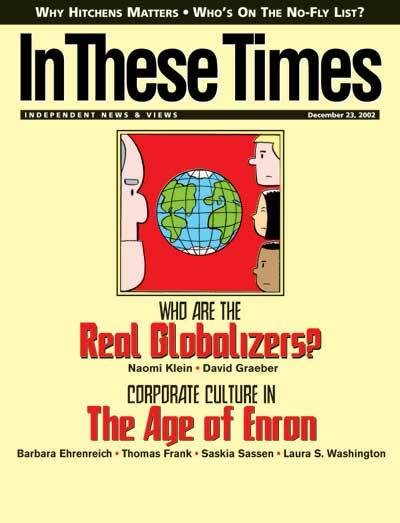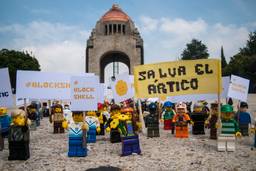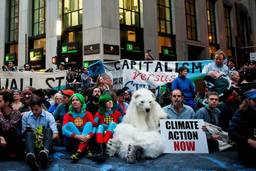
Like others who found themselves in this global web, I arrived equipped with only a limited understanding of neoliberal economics, mostly how they related to young people growing up over-marketed and underemployed in North America and Europe. But I have been globalized by this movement: I have received a crash course on what the market obsession has meant to landless farmers in Brazil, to teachers in Argentina, to fast-food workers in Italy, to coffee growers in Mexico, to shantytown dwellers in South Africa, to telemarketers in France, to migrant tomato pickers in Florida, to union organizers in the Philippines, to homeless kids in Toronto, the city where I live.
A few months into George W. Bush’s “war on terrorism,” I realized that something had ended. Some politicians rushed to declare that what had ended was the movement itself: The concerns it raised about globalization’s failures are frivolous, they claimed, even fodder for “the enemy.” In fact, the escalation of military force and repression over the past year has provoked the largest protests yet on the streets of Rome, London, Barcelona and Buenos Aires. It also has inspired many activists, who had previously registered only symbolic dissent outside of summits, to take concrete actions to de-escalate the violence. These actions have included serving as “human shields” during the standoff at the Church of the Nativity in Bethlehem, as well as attempting to block illegal deportations of refugees at European and Australian detention centers.
But as the movement entered this challenging new stage, I realized I had been witness to something extraordinary: the precise and thrilling moment when the rabble of the real world crashed the experts-only club where our collective fate is determined.
————–
A few months ago, while riffling through my column clippings searching for a lost statistic, I noticed a couple of recurring themes and images. The first was the fence. The image came up again and again: barriers separating people from previously public resources, locking them away from much-needed land and water, restricting their ability to move across borders, to express political dissent, to demonstrate on public streets.
Some of these fences are hard to see, but they exist all the same. A virtual fence goes up around schools in Zambia when an education “user fee” is introduced on the advice of the World Bank, putting classes out of the reach of millions of people. A fence goes up around the family farm in Canada when government policies turn small-scale agriculture into a luxury item, unaffordable in a landscape of tumbling commodity prices and factory farms. A fence goes up around clean water in South Africa when prices skyrocket owing to privatization, and residents are forced to turn to contaminated sources. And there is a fence that goes up around the very idea of democracy when Argentina is told it won’t get an International Monetary Fund loan unless it further reduces social spending, privatizes more resources and eliminates supports to local industries, all in the midst of an economic crisis deepened by those very policies.
Fences have always been a part of capitalism, the only way to protect property from would-be bandits, but the double standards propping up these fences have, of late, become increasingly blatant. Expropriation of corporate holdings may be the greatest sin any socialist government can commit in the eyes of the international financial markets (just ask Venezuela’s Hugo Chavez or Cuba’s Fidel Castro). But the asset protection guaranteed to companies under free trade deals did not extend to the Argentine citizens who deposited their life savings in Citibank, Scotiabank and HSBC accounts and now find that most of their money has simply disappeared. Neither did the market’s reverence for private wealth embrace the U.S. employees of Enron, who found that they had been “locked out” of their privatized retirement portfolios, unable to sell even as executives were frantically cashing in their own stocks.
The past decade of economic integration has been fueled by promises of barriers coming down, of increased mobility and greater freedom. And yet 13 years after the celebrated collapse of the Berlin Wall, we are surrounded by fences yet again, cut off—from one another, from the earth and from our own ability to imagine that change is possible.
————–
The economic process that goes by the benign euphemism “globalization” now reaches into every aspect of life, transforming every activity and natural resource into a measured and owned commodity. As Hong Kong-based labor researcher Gerard Greenfield points out, the current stage of capitalism is not simply about trade in the traditional sense of selling more products across borders. It is also about feeding the market’s insatiable need for growth by redefining as “products” entire sectors that were previously considered part of “the commons” and not for sale. The invading of the public by the private has reached into categories such as health and education, of course, but also into seeds, genes, ideas.
With copyright now the single-largest U.S. export (more than manufactured goods or arms), international trade law must be understood not only as taking down selective barriers to trade, but more accurately as a process that systematically puts up new barriers—around knowledge, technology and newly privatized resources. These are what prevent farmers from replanting their Monsanto-patented seeds and make it illegal for poor countries to manufacture cheaper generic drugs to get to their needy populations.
Globalization is now on trial because on the other side of all these virtual fences are real people, shut out of schools, hospitals, workplaces, their own farms, homes and communities. Mass privatization and deregulation have bred armies of locked-out people, whose services are no longer needed, whose lifestyles are written off as “backward,” whose basic needs go unmet. These fences of social exclusion can discard an entire industry, and they can write off an entire country, as has happened to Argentina. In the case of Africa, essentially an entire continent can find itself exiled to the global shadow world, off the map and off the news, appearing only during wartime when its citizens are looked on with suspicion as potential militia members, would-be terrorists or anti-American fanatics.
In fact, remarkably few of globalization’s fenced-out people turn to violence. Most simply move: from countryside to city, from country to country. And that’s when they come face to face with the fences made of chain link and razor wire, reinforced with concrete and guarded with machine guns. Whenever I hear the phrase “free trade,” I can’t help picturing the caged factories I visited in the Philippines and Indonesia that are all surrounded by gates, watchtowers and soldiers—to keep the highly subsidized products from leaking out and the union organizers from getting in.
I think, too, about a recent trip to the South Australian desert where I visited the infamous Woomera detention center, a former military base that has been converted into a privatized refugee holding pen, owned by a subsidiary of the U.S. security firm Wackenhut. At Woomera, hundreds of Afghan and Iraqi refugees, fleeing oppression and dictatorship in their own countries, are so desperate for the world to see what is going on behind the fence that they stage hunger strikes, jump off the roofs of their barracks, drink shampoo and sew their mouths shut.
These days, newspapers are filled with gruesome accounts of asylum seekers attempting to make it across national borders by hiding themselves among the products that enjoy so much more mobility than they do. In December 2001, the bodies of eight Romanian refugees were discovered in a cargo container filled with office furniture; they had asphyxiated during the long journey at sea. The same year, the dead bodies of two more refugees were discovered in Eau Claire, Wisconsin, in a shipment of bathroom fixtures. The year before, 58 Chinese refugees from Fujian province suffocated in the back of a delivery truck in Dover, England.
————–
All these fences are connected: the real ones, made of steel and razor wire, are needed to enforce the virtual ones, the ones that put resources and wealth out of the hands of so many. It simply isn’t possible to lock away this much of our collective wealth without an accompanying strategy to control popular unrest and mobility. Security firms do their biggest business in the cities where the gap between rich and poor is greatest—Johannesburg, São Paulo, New Delhi—selling iron gates, armored cars, elaborate alarm systems and renting out armies of private guards.
Brazilians, for instance, spend $4.5 billion a year on private security, and the country’s 400,000 armed rent-a-cops outnumber actual police officers by 3-to-1. In deeply divided South Africa, annual spending on private security has reached $1.3 billion, more than three times what the government spends each year on affordable housing. It now seems that these gated compounds protecting the haves from the have-nots are microcosms of what is fast becoming a global security state.
If this picture seems extreme, it may be only because most of us in the West rarely see the fences and the artillery. The gated factories and refugee detention centers remain tucked away in remote places. But over the past few years, some fences have intruded into full view—often, fittingly, during the summits where this brutal model of globalization is advanced. It is now taken for granted that if world leaders want to get together to discuss a new trade deal, they will need to build a modern-day fortress to protect themselves from public rage, complete with tanks, tear gas, water cannons and attack dogs.
When Quebec City hosted the Summit of the Americas in April 2001, the Canadian government took the unprecedented step of building a cage around not just the conference center, but the downtown core, forcing residents to show official documentation to get to their homes and workplaces. Another popular strategy is to hold the summits in inaccessible locations: the 2002 G-8 meeting was held deep in the Canadian Rockies, and the 2001 WTO meeting took place in the repressive Gulf state of Qatar, where the emir bans political protests. The “war on terrorism” has become yet another fence to hide behind, used by summit organizers to explain why public shows of dissent just won’t be possible this time around or, worse, to draw threatening parallels between legitimate protesters and terrorists bent on destruction.
————–
But what are reported as menacing confrontations are often joyous events, as much experiments in alternative ways of organizing societies as criticisms of existing models. The first time I participated in one of these counter-summits, I remember having the distinct feeling that some sort of political portal was opening up—a gateway, a window, “a crack in history,” to use Subcomandante Marcos’ beautiful phrase.
This opening had little to do with a broken window at the local McDonald’s, the image so favored by television cameras; it was something else: a sense of possibility, a blast of fresh air, oxygen rushing to the brain. These protests—which are actually week-long marathons of intense education on global politics, late-night strategy sessions in six-way simultaneous translation, festivals of music and street theater—are like stepping into a parallel universe. Overnight, the site is transformed into a kind of alternative global city where urgency replaces resignation, corporate logos need armed guards, people usurp cars, art is everywhere, strangers talk to each other, and the prospect of a radical change does not seem like an odd and anachronistic idea but the most logical thought in the world.
Even the heavy-handed security measures have been co-opted by activists into part of the message: The fences that surround the summits become metaphors for an economic model that exiles billions to poverty and exclusion. Confrontations are staged at the fence—but not only the ones involving sticks and bricks. Tear-gas canisters have been flicked back with hockey sticks, water cannons have been irreverently challenged with toy water pistols and buzzing helicopters mocked with swarms of paper airplanes. These activists are quite serious in their desire to disrupt the current economic order, but their tactics reflect a dogged refusal to engage in classic power struggles: Their goal is not to take power for themselves, but to challenge power centralization on principle.
Other kinds of windows are opening as well, quiet conspiracies to reclaim privatized spaces and assets for public use. Maybe it’s students kicking ads out of their classrooms, or swapping music online, or setting up independent media centers with free software. Maybe it’s Thai peasants planting organic vegetables on over-irrigated golf courses, or landless farmers in Brazil cutting down fences around unused lands and turning them into farming co-operatives. Maybe it’s Bolivian workers reversing the privatization of their water supply, or South African township residents reconnecting their neighbors’ electricity under the slogan “Power to the People.” And once reclaimed, these spaces are also being remade. In neighborhood assemblies, at city councils, in community-run forests and farms, a new culture of vibrant direct democracy is emerging, one that is fueled and strengthened by direct participation, not dampened and discouraged by passive spectatorship.
Despite all the attempts at privatization, it turns out there are some things that don’t want to be owned. Music, water, seeds, electricity, ideas—they keep bursting out of the confines erected around them. They have a natural resistance to enclosure, a tendency to escape, to cross-pollinate, to flow through fences, and flee out open windows.

I hope you found this article important. Before you leave, I want to ask you to consider supporting our work with a donation. In These Times needs readers like you to help sustain our mission. We don’t depend on—or want—corporate advertising or deep-pocketed billionaires to fund our journalism. We’re supported by you, the reader, so we can focus on covering the issues that matter most to the progressive movement without fear or compromise.
Our work isn’t hidden behind a paywall because of people like you who support our journalism. We want to keep it that way. If you value the work we do and the movements we cover, please consider donating to In These Times.
Naomi Klein is a former columnist for In These Times. She is the author of No Logo: Taking Aim at the Brand Bullies, Fences and Windows: Dispatches from the Front Lines of the Globalization Debate and The Shock Doctrine: The Rise of Disaster Capitalism.








